Review of the population structure of Finland 2010
1. Age structure of foreign citizens resident in Finland clearly younger than that of native population
The foreign citizens resident in Finland are notably younger than the rest of the population. At the end of 2010, the average ages among the foreign citizens were 33.7 years for men and 34.4 years for women. The respective average ages among the total population were 40.0 years for men and 42.8 years for women.
Figure 1. Finnish citizens by age and gender at the end of 2010
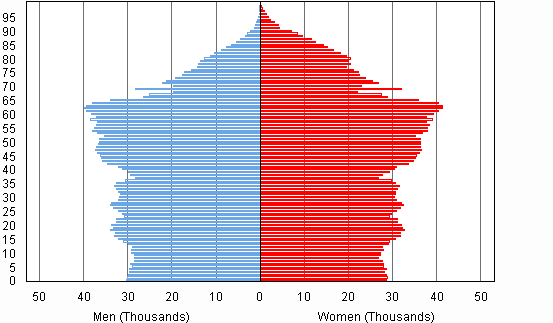
Figure 2. Foreign citizens by age and gender at the end of 2010
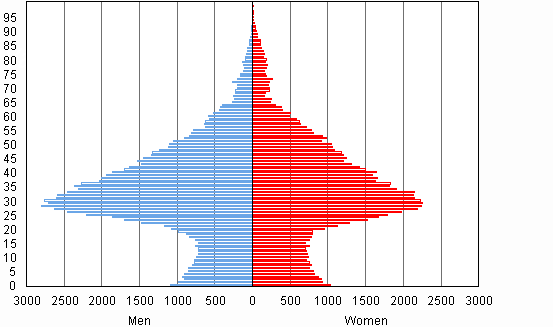
The demographic dependency ratio among the foreign citizens was 24.0 (51.6 for total population) and as many as 80.6 per cent of the foreign citizens belong to the working-age population, that is, are aged between 15 and 64. The growth in the number of foreign citizens is not solely due to new immigrants. In 2010, for instance, a total of 2,107 foreign citizens were born in Finland.
Foreign citizens number 168,000 and 55,000 persons hold dual citizenship
At the end of 2010, foreign citizens resident in Finland numbered 167,954, making up 3.1 per cent of the population. During 2010, Estonian citizens became the largest group of foreign citizens with 29,080 of them living in Finland. In the past, citizens of Russia has been the largest group of foreign citizens. They have lived in Finland longer than Estonian citizens and nearly 20,000 of them have applied for and been granted Finnish citizenship.
In the population resident in Finland, 54,783 have dual citizenship, i.e. in addition to Finnish citizenship, also hold the citizenship of some other country. The largest dual nationality groups were citizens of Russia (15,348), Sweden (5,275) and the United States (3,220). Persons with dual citizenship are not included in foreign citizens in official statistics because they hold Finnish citizenship.
2. Russian is the native language of nearly one out of four foreign-language speakers
At the end of 2010, there were 224,388 foreign-language speakers in Finland. The number grew by 17,351 persons from the previous year. The number of foreign-language speakers passed the 100,000 mark in 2001 and the 200,000 mark in 2009. There are now 31 different foreign-language groups with at least 1,000 speakers in Finland.
Figure 3. Number of foreign-language speakers in Finland in 1990-2010
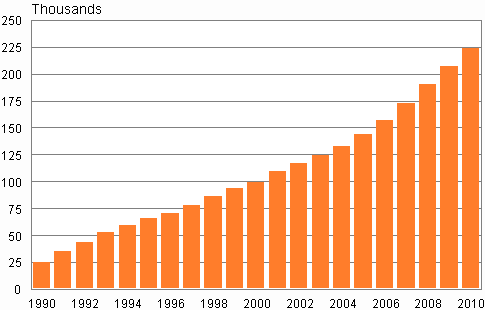
The sizes of all the largest language groups shown in Figure 4 grew during 2010. Speakers of Russian make up the largest foreign-language group in Finland. Russian-speakers in Finland already number as many as 54,559 and their share of all the foreign-language speakers in the population is 24 per cent. The next largest foreign-language groups spoke Estonian (28,493 persons), Somali (12,985 persons), English (12,855 persons) and Arabic (10,415 persons).
Figure 4. Largest groups of foreign-language speakers in 2009 and 2010
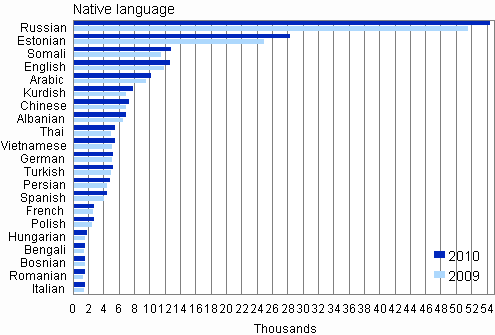
One person in ten living in the capital region is a foreign-language speaker
Relative to the population the shares of foreign-language speakers are the highest in Uusimaa at 8.0 per cent and in Åland at 5.2 per cent. The number of foreign-language speakers is the lowest in South Ostrobothnia where their share of the population is 1.2 per cent.
Examined by municipality, the share of foreign-language speakers is the highest in Helsinki where 10.8 per cent of the population are foreign-language speakers. Vantaa has the second highest share of 9.9 per cent and Espoo the third highest of 9.4 per cent. In 15 Finnish municipalities, the share of foreign-language speakers exceeds five per cent of the population. In 117 municipalities, their share is under one per cent.
3. Migration loss has worsened demographic dependency ratio in Etelä-Savo and Kainuu
For decades, migration loss has been worsening the demographic dependency ratio especially in Etelä-Savo and Kainuu. Demographic dependency ratio gives the combined number of persons aged under 15 and over 65 per one hundred persons of working aged (aged between 15 and 64). In 1980, the demographic dependency ratio was 45 in both the region of Uusimaa and the region of Kainuu.
Figure 5. Demographic dependency ratio by region in 1980 and 2010
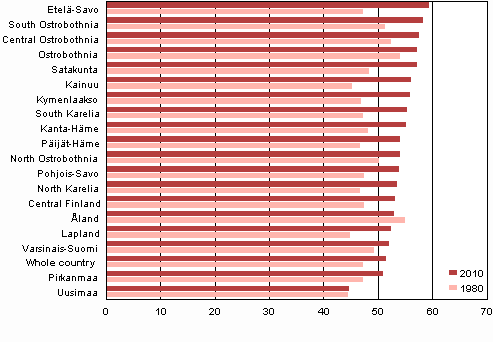
At the end of 2010, the demographic dependency ratio still stood at 45 in Uusimaa whereas in Kainuu it was 56. The region of Etelä-Savo had the highest demographic dependency ratio of 59. As late as 1980, Etelä-Savo's demographic dependency ratio was still 48.
Number of young persons in the regions has fallen by up to one-third in 30 years
Migration losses have already had a permanent impact on population development in the regions. Over the past 10 years, deaths have exceeded births every year in the regions of South Karelia, Etelä-Savo, Kainuu, Kymenlaakso, North Karelia, Pohjois-Savo and Satakunta.
In the region of Etelä-Savo, 6,428 more persons have died than been born during the past decade. The corresponding figure for Kymenlaakso is 5,035 persons. Over the same period, the region of Uusimaa has had 70,294 more births than deaths.
The number of persons aged under 15 has decreased by at least 30 per cent in the past 30 years in the regions of South Karelia, Etelä-Savo, Kainuu, Lapland and Satakunta. The number of persons aged under 15 has decreased by most, or by 44 per cent, since 1980 in the region of Kainuu.
Source: Population Structure 2010, Statistics Finland
Inquiries: Markus Rapo (09) 1734 3238, vaesto.tilasto@stat.fi
Director in charge: Jari Tarkoma
Updated 30.9.2011
Official Statistics of Finland (OSF):
Population structure [e-publication].
ISSN=1797-5395. annual review 2010,
Review of the population structure of Finland 2010
. Helsinki: Statistics Finland [referred: 16.4.2024].
Access method: http://www.stat.fi/til/vaerak/2010/01/vaerak_2010_01_2011-09-30_kat_001_en.html

